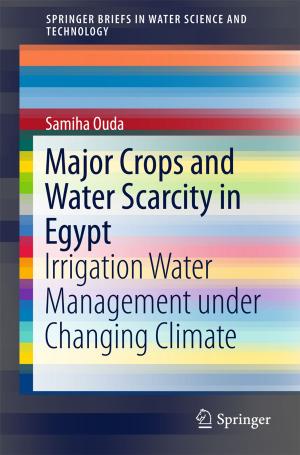Food Safety for Farmers Markets: A Guide to Enhancing Safety of Local Foods
Nonfiction, Science & Nature, Science, Biological Sciences, Microbiology, Technology, Food Industry & Science| Author: | ISBN: | 9783319666891 | |
| Publisher: | Springer International Publishing | Publication: | October 20, 2017 |
| Imprint: | Springer | Language: | English |
| Author: | |
| ISBN: | 9783319666891 |
| Publisher: | Springer International Publishing |
| Publication: | October 20, 2017 |
| Imprint: | Springer |
| Language: | English |
This book describes practices used on farms and in farmers markets selling foods directly to consumers in U.S. and international markets. It identifies hazards associated with those practices that could put consumers at increased risk for foodborne illness. It also provides tools for identifying hazards on farms and in markets and guidance for establishing food-safe markets.
The local food movement, inspired by initiatives such as the USDA’s “Know Your Farmer, Know Your Food”; “Farm to School”; “Farm to Pre-school”; and “The People’s Garden”, is sweeping the country. Nowhere is this interest more evident than at farmers markets. The number of farmers markets has increased almost 400% since the early 1990s, with over 8,600 farmers markets listed in the USDA’s market directory in 2016. Many of the customers for local markets are senior adults, people who may have health concerns, and mothers with young children shopping for foods they perceive to be healthier and safer than those available in grocery stores. This means that many of the customers may be in population groups that are most at risk for foodborne illness and the serious complications that can result.
In surveys, however, farmers selling directly to consumers self-reported practices that could increase risk for foodborne illnesses. These included use of raw manure as fertilizer without appropriate waiting periods between application and harvest, as outlined in the National Organic Program, a lack of sanitation training for farm workers handling produce, a lack of proper cleaning and sanitizing of surfaces that come in contact with produce, and use of untested surface water for rinsing produce before taking it to market. Surveys of market managers found that many had limited experience and most had no food safety plans for their markets.
Observational studies in markets have corroborated self-reported practices that could increase foodborne illness risks, including lack of handwashing, lack of access to well-maintained toilet and handwashing facilities, use of materials that cannot be cleaned and sanitized appropriately, and lack of temperature control for foods that must have time and temperature controlled for safety. These potential food safety risks are not only seen in U.S. farmers markets, but also have been identified in international markets.
This book is unique in that it provides evidence-based information about food safety hazards and potential risks associated with farmers markets. It presents an overview of farm and market practices and offers guidance for enhancing food safety on farms and in markets for educators, farmers, producers, vendors and market managers.
Dr. Judy A. Harrison is a Professor in the Department of Foods and Nutrition at the University of Georgia (UGA) where she has been named a Walter Bernard Hill Fellow for distinguished achievement in public service and outreach. Serving as a food safety specialist for UGA Cooperative Extension, she has provided 25 years of food safety education for a variety of audiences across the food system.
This book describes practices used on farms and in farmers markets selling foods directly to consumers in U.S. and international markets. It identifies hazards associated with those practices that could put consumers at increased risk for foodborne illness. It also provides tools for identifying hazards on farms and in markets and guidance for establishing food-safe markets.
The local food movement, inspired by initiatives such as the USDA’s “Know Your Farmer, Know Your Food”; “Farm to School”; “Farm to Pre-school”; and “The People’s Garden”, is sweeping the country. Nowhere is this interest more evident than at farmers markets. The number of farmers markets has increased almost 400% since the early 1990s, with over 8,600 farmers markets listed in the USDA’s market directory in 2016. Many of the customers for local markets are senior adults, people who may have health concerns, and mothers with young children shopping for foods they perceive to be healthier and safer than those available in grocery stores. This means that many of the customers may be in population groups that are most at risk for foodborne illness and the serious complications that can result.
In surveys, however, farmers selling directly to consumers self-reported practices that could increase risk for foodborne illnesses. These included use of raw manure as fertilizer without appropriate waiting periods between application and harvest, as outlined in the National Organic Program, a lack of sanitation training for farm workers handling produce, a lack of proper cleaning and sanitizing of surfaces that come in contact with produce, and use of untested surface water for rinsing produce before taking it to market. Surveys of market managers found that many had limited experience and most had no food safety plans for their markets.
Observational studies in markets have corroborated self-reported practices that could increase foodborne illness risks, including lack of handwashing, lack of access to well-maintained toilet and handwashing facilities, use of materials that cannot be cleaned and sanitized appropriately, and lack of temperature control for foods that must have time and temperature controlled for safety. These potential food safety risks are not only seen in U.S. farmers markets, but also have been identified in international markets.
This book is unique in that it provides evidence-based information about food safety hazards and potential risks associated with farmers markets. It presents an overview of farm and market practices and offers guidance for enhancing food safety on farms and in markets for educators, farmers, producers, vendors and market managers.
Dr. Judy A. Harrison is a Professor in the Department of Foods and Nutrition at the University of Georgia (UGA) where she has been named a Walter Bernard Hill Fellow for distinguished achievement in public service and outreach. Serving as a food safety specialist for UGA Cooperative Extension, she has provided 25 years of food safety education for a variety of audiences across the food system.















